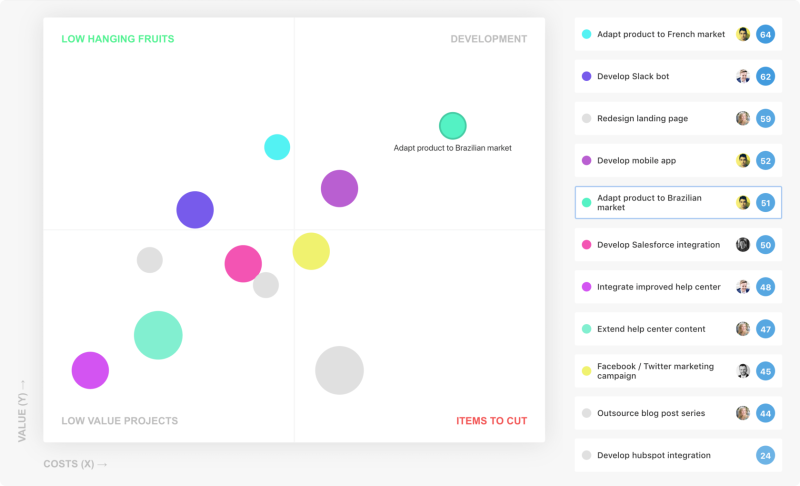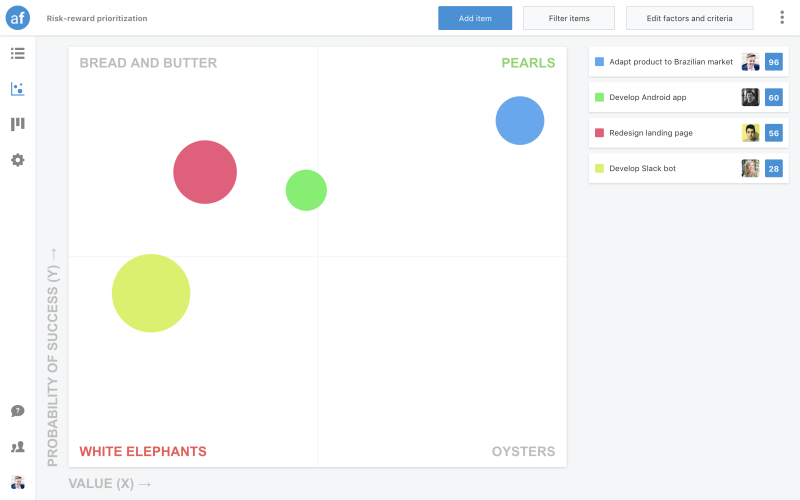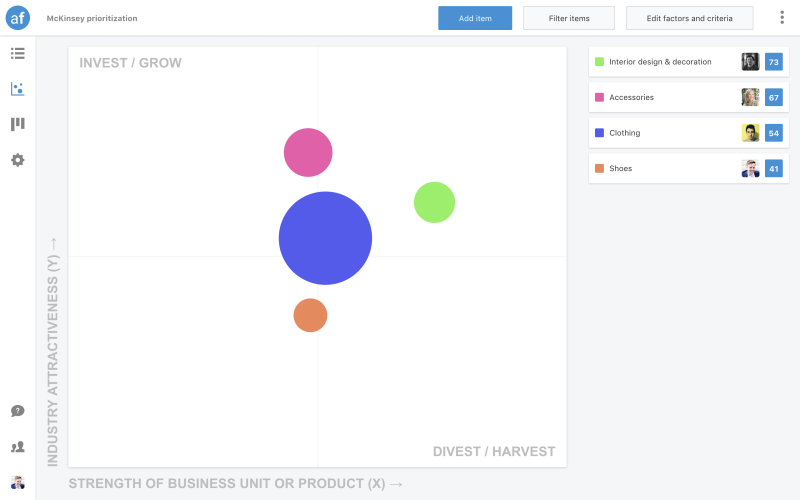5 Prioritization Templates That Help You Focus On the Right Stuff

Prioritization is key to any organization.
But the way how you prioritize differs strongly from whatever you and your teams aim to achieve. A product manager of a software startup who tries to develop a coherent feature roadmap naturally works under different conditions and constraints than a project manager in the construction business who needs to decide between suppliers.
So what is the right method for you and the job that you are trying to get done? One answer is looking at what management literature offers and adjusting these proven project prioritization templates to your own situation.
Find below five hand-picked prioritization templates that help you focus on the right stuff using a decision matrix.
What is a prioritization framework template?
As you know by now, there are countless ways to prioritize your upcoming work. Each framework visualizes the data in a different way and building something from scratch every time you need to prioritize is going to put a dent into your productivity. This is where prioritization framework templates — like these, for example — come into play.
Templates are helpful for almost every part of product management, from Kanban boards to roadmapping. They simply act as a tool to save product teams time and effort so we can get right to business with everything we need to make better decisions. The less time we spend on menial tasks, the more time we have to focus on adding value to our products.
Prioritization framework template benefit: Time-saving
Even if creating a visualization of your decision-making process takes five minutes, that’s five minutes that could have been used to add value elsewhere.
Say you’re building a simple weighted decision matrix. Creating that matrix takes valuable time out of the beginning of a session when everyone’s minds are most active. Your team could have come up with a great feature idea or crucial prioritization judgment during the time it takes to build the matrix.
The more time you spend away from the product, the less value you can add to it.
Prioritization framework template benefit: Easy to update
Building your own visualizations often means including the bare minimum. Everyone’s conscious of time, so there’s often no time to include enough room to scale up or adjust.
Using a pre-built prioritization framework template often allows you far more space than you’ll need, which makes last-minute additions a breeze. Using a digital prioritization framework template also allows for easy editing and updating as the project progresses, with a handy undo button just in case.
Prioritization framework template benefit: Easy to share
Back in the days of old, roadmaps, Kanban boards, and prioritization charts had to be created on a wall or portable whiteboard so it was large enough for everyone to see. A wall can’t be moved (not easily, at least) and dragging around a whiteboard every time someone in another room needs to take a look is more hassle than it’s worth.
These days, we have the cloud. Cloud-based project management software makes it incredibly simple to share templates between teams and stakeholders. With a few simple clicks, another member of the team can see and collaborate on prioritization charts, even if they’re on the other side of the world.
Prioritization framework template benefit: Can be integrated with your roadmaps
Manually translating your prioritization efforts onto your roadmap can be tedious and confusing. Cloud-based project management platforms like airfocus make it easy to take your prioritization results and view them on your roadmap.
How to prioritize when everything is a priority?
There’s going to be a moment when prioritization seems impossible. Every item in the product backlog is crucial to the product and, in the team’s eyes, every item is equally a priority.
Using a prioritization framework template allows teams to look at the items objectively. You can score each item against a set of criteria to identify which is truly the most important.
Prioritization according to McKinsey
There are few companies that know the value of product prioritization more than McKinsey. The management consulting company has been preaching prioritization for a long time now, and with good reason. Their research found that companies that use regular evaluations and prioritization can be worth around 40% more than companies that don’t.
However, it’s not just their research that backs up the importance of prioritization. McKinsey uses prioritization throughout everything they do, with one manager saying “everything you do should be prioritized, whether it is figuring out what you are going to do today, analyzing data, or communicating recommendations”.
Prioritizing prioritization helps teams to understand the magnitude of every decision they make. It helps uncover value, creates more options and helps them to understand the opportunity cost, resulting in great products every single time.
Former McKinsey employee Joe Newsum has another way to think about prioritization. The idea is to understand and rank order the relative ROI of a set of options. By focusing on cost-benefit analysis and combining that with prioritization and decision matrices, teams can better understand the relative return on investment for all their options.
#1 — Feature prioritization
Prioritization is a perennial challenge when building a product roadmap. This template will help you build the right features and products. This template is particularly useful for product managers and software entrepreneurs.
Business value (y-factor)
Revenue increase: Does this feature increase your revenue
Customer value: Does this feature add value to your customers
Strategic fit: How aligned is this feature with your company strategy
Effort (x-factor)
Development costs: What are the initial costs to develop this feature?
Marketing & sales costs: What are the costs to market and promote this feature?
Maintenance costs: What are the costs to maintain this feature after its release?
Risk (bubble size)
How big are the risks and dependencies for the development of this feature?

#2 — Risk-reward prioritization
Find your oysters, white elephants, pearls, or bread and butter projects. This prioritization template will force you to deal with resource issues. Oysters are hard projects with a low success probability but a high business value if successful. Bread and butter initiatives have a high chance of succeeding but a relatively low business value if successful. Pearls are easy projects with large value – they are often oysters that have come close to succeeding and may provide sustainable benefits for your business. Don't follow up with the white elephants as they are projects that are unlikely and not valuable. This template is commonly used by project managers, product managers, marketing managers, and CXOs (chief officers for anything).
Probability of success (y-factor)
Criteria for this y-factor
Technical: What is the probability of technical success?
Commercial: What is the probability of commercial success
Value (x-factor)
Criteria for this x-factor
Benefits after years of launch: How big are the long-term benefits of this project?
Market value: Does this project increase your market value?
People or work-month allocated to the project (bubble size)
Definition of the bubble size factor: How many resources do you need to spend on this project?

#3 — Business strategy prioritization
Prioritize your ideas and projects based on their strategic fit, economic impact, and feasibility. Project managers, product managers, marketing experts, consultants, and entrepreneurs of all kinds get the most value out of this project prioritization template.
Strategic fit (y-factor)
Alignment with company goals: How aligned is this project to your corporate goals?
Market positioning: Does this project position you better in the market?
Core capabilities: Does this project improve your core capabilities and competencies
Feasibility (x-factor)
Technical risk: How big are the technical challenges of the project?
Resources financial: What are the financial resources to execute this project?
Resources people: Do you have the skills and bandwidth to execute this project?
Economic impact (bubble size)
What is the economic impact of the project?

#4 — Boston Consulting Group prioritization
Use the Boston Consulting Group (BCG) priority matrix template if you need to distribute money or resources across your business units or products. Find your poor dogs, question marks, stars, and cash cows. This template is one of the most cited management frameworks and delivers the best outcomes for high-level, strategic decisions.
Market growth rate (y-factor)
What is the growth rate of your business units or products in their respective markets?
Relative market share (x-factor)
What is the relative share of your business units or products in their respective markets?
Allocated resources (bubble size)
How many resources do you need to allocate to this project?

#5 — McKinsey prioritization
Prioritizing your business portfolio will empower you to develop growth strategies and make keep or kill decisions for your business units. The McKinsey project prioritization templates are often used by entrepreneurs, strategy consultants, and top-level managers.
Industry attractiveness (y-factor)
Industry growth rate: What is the long-run growth rate of the industry?
Industry size: How big is the industry?
Industry profitability: How profitable is the industry? Consider using Porter's Five Forces framework at this stage to determine profitability.
Industry structure: How is the industry structured? Consider applying a Structure-Conduct-Performance framework to determine this.
Trends of prices: Do price trends influence the industry in a positive or negative way?
Market segmentation: Does the market segmentation influence the industry in a positive or negative way
Strength of business unit or product (x-factor)
Market share: What are the market shares of your business units or products?
Relative growth rate: What are the relative growth rates of your business units or products?
Company's profitability: How profitable is your business unit or product?
Brand value: How big is the value of your brand?
CPM score: How big is your score?
The proportion of the business revenue generated by that business unit (bubble size)

It's time to get started. Put these prioritization templates to test with airfocus and find out in minutes what you should focus on.
airfocus enables you to visually map your priorities on a chart and transform them into an actionable roadmap at the click of a button.

Malte Scholz

Read also

Prioritize with confidence

Experience the new way of doing product management






